Mkw Custom Track Mario Kart Arcade Gp 2
| |
| Mario Kart Wii |
|---|
| Developer: Nintendo |
Mario Kart Wii is the sixth game in the series (not counting Arcade editions), which introduced bikes and... Mushroom Gorge.
Contents
- 1 Sub-Pages
- 1.1 Courses
- 1.2 Characters and Vehicles
- 1.3 Graphics
- 1.4 Menus
- 1.5 Misc.
- 1.6 Regional Differences
- 2 Unused Character Icons
- 2.1 Petey Piranha
- 2.2 Koopa Paratroopa
- 2.3 Hammer Bro
- 2.4 Mii Outfit C
- 3 Unused Code
- 3.1 Player Number on the Minimap
- 3.2 Exception Handler
- 3.3 Alternative Main Loop with Performance Monitor
- 3.4 Network Debug Messages "DWC_Log"
- 3.5 Draggable Blue Shells
- 3.6 Double-Sized Green Shells
- 3.7 Unused kartCameraParam.bin Parameters
- 3.8 Online Squish Command
- 3.9 Unused Collision Type Effects
- 3.9.1 Slippery Road 1 (does not slow the player) (0x01)
- 3.9.2 Off-road (0x03)
- 3.9.3 Slippery Road 2 (slows the player) (0x05)
- 3.9.4 Boost Panel (0x06)
- 3.9.5 Boost Ramp (0x07)
- 3.9.6 Jump Pad (0x08)
- 3.9.7 Item Road (0x09)
- 3.9.8 Moving Road (0x0B)
- 3.9.9 Invisible Wall (0x0D)
- 3.9.10 Item Wall (0x0E)
- 3.9.11 Wall 3 (0x0F)
- 3.9.12 Cannon Activator (0x11)
- 3.9.13 Half-pipe Ramp (0x13)
- 3.9.14 Wall (0x14)
- 3.9.15 Moving Road (0x15)
- 3.9.16 Road (0x17)
- 3.9.17 Wall (0x19)
- 3.9.18 Effect Trigger (0x1A)
- 3.9.19 Item State Modifier (0x1B)
- 3.9.20 Half-Pipe Invisible Wall (0x1C)
- 3.9.21 Rotating Road (0x1D)
- 3.9.22 Special Wall (0x1E)
- 3.9.23 Wall 5 (0x1F)
- 4 Unused Music
- 4.1 o_FanfareMIWinBoss_32.brstm
- 4.2 STRM_N_TRUCK_N.brstm
- 5 Unused Sound Effects
- 5.1 Early Trick Sound
- 6 Unused Items
- 6.1 Chain Chomp
- 6.2 Boo
- 6.3 Placeholder Items
- 7 Empty or Deleted Folders & Files
- 7.1 Debug Folder
- 7.2 MissionRun Folder
- 7.3 .svn Folders
- 7.4 Scrapped 3D Wiimote Model
- 7.5 Scrapped Character Sound Method
- 7.6 Unused Dutch Language
- 7.7 Unused _Dif Files
- 7.8 BMS Files
- 7.9 BFOG and BFOBJ Files
- 7.10 BDOF File Extra Functions
- 7.11 Removed Symbol Maps
- 7.12 Alternative Mario Kart Channel version
- 7.13 RKChRes.arc
- 8 Unused Modes
- 8.1 Mission Mode
- 8.1.1 Game Modes
- 8.1.2 Unused/Disabled Menu Content
- 8.1.3 Accessing Mission Mode
- 8.2 Special Ghosts Mode
- 8.1 Mission Mode
- 9 Early File Leftovers
- 9.1 kartParam.bin
- 9.2 driverParam.bin
- 9.3 kartCameraParam.bin
- 10 Unreleased Chinese Version
- 10.1 Simplified Chinese Logo
- 10.2 Simplified Chinese Wii Menu Banner
- 10.3 Chinese Safety Screen
- 10.4 isbn_608x456
- 10.5 Chinese Home Button Menu
- 11 Uncompiled Camera Animation
- 12 Internal Project Name
- 13 Regional Differences
- 13.1 Title Screen
- 13.2 License Selection Screen and Main Menu
- 13.3 Font
Sub-Pages
Courses
Characters and Vehicles
Graphics
| | BRLYT Text Unused text left across many layout files. |
Misc.
| | Oddities It's no Space Oddity, but these are pretty odd nonetheless. |
Regional Differences
| | Spanish Translation Differences For the first time ever on the entirety of TCRF, we are going to cover the Spanish text differences instead of just putting it on the "To do" list and ignoring its existence! (Experimental Project) |
| | French Translation Differences For the first time ever on the entirety of TCRF, we snapped "To do" list from this section and this is now complete outside, but incomplete inside (Experimental Project) |
Unused Character Icons
Petey Piranha
 Petey Piranha's icon appears in the game files. He was a playable character in Mario Kart: Double Dash!!, but was scrapped here.
Petey Piranha's icon appears in the game files. He was a playable character in Mario Kart: Double Dash!!, but was scrapped here.
Koopa Paratroopa
 Paratroopa was also a playable character in Double Dash!!. Interestingly, he uses a different pose here than in the final Double Dash!! icon.
Paratroopa was also a playable character in Double Dash!!. Interestingly, he uses a different pose here than in the final Double Dash!! icon.

This same icon can be seen in early screenshots of Double Dash!!.
This was probably the one to be cut earliest in development, as Petey and the Hammer Bro are facing left and fit along with the final character icons, whereas this one stands out like a sore thumb.
Hammer Bro
 An icon of a Hammer Bro exists in the game files. This would have been Hammer Bro's debut in the Mario Kart series, before their eventual inclusion in Mario Kart Tour.
An icon of a Hammer Bro exists in the game files. This would have been Hammer Bro's debut in the Mario Kart series, before their eventual inclusion in Mario Kart Tour.
Mii Outfit C
 Apparently, there was going to be a Mii Outfit C. Oddly, though, it has a different icon compared to Outfits A and B. While Outfits A and B are circles with "Mii" on them, C appears to be a grey jacket with the letter "C" on it, suggesting it didn't get much further than testing.
Apparently, there was going to be a Mii Outfit C. Oddly, though, it has a different icon compared to Outfits A and B. While Outfits A and B are circles with "Mii" on them, C appears to be a grey jacket with the letter "C" on it, suggesting it didn't get much further than testing.
Leftover parameter data for Mii Outfit C still exists in the game, like character identifiers, parameters for the size of the Mii's head, etc.
A button also exists for Mii Outfit C, but due to the way it's coded, the character ID is immediately replaced with Mii Outfit A when selected. Fixing this "bug" reveals that Mii Outfit C fails to load because all of its files have been removed from the disc. If these files are replaced, Mii Outfit C will work as intended.
A Gecko code to load Mii Outfit C in-game is available at MarioKartWii.com.
Unused Code
Player Number on the Minimap

There's a disabled feature in the minimap icons to display a line with the player number on it, similar to Double Dash!!. It is very big, and player icon headlights are rendered on top of it, making it invisible when they overlap. The colors for each player also seem to be in line with the Wii's default, rather than the different format the game uses.
A Gecko code to enable it is available at MarioKartWii.com.
Exception Handler

When the game crashes, press the following buttons (in order, from left to right) on the 1st Wii Remote (Vertical) to bring up an exception handler:
Up, 1, Down, 2, Right, -, Left, +, B, A
Use the D-Pad to scroll.
Alternative Main Loop with Performance Monitor
Mario Kart Wii has two main game loops. The used one is game-specific, but there is an extra unused loop included in the EGG library, shared across multiple games. The following differences are known:
- The health and safety screen on startup has an instance of EGG's ProcessMeter, with three bars on the bottom of the screen displaying CPU, GPU, and overall usage. This screen also doesn't listen to GameCube controllers.
- The game immediately displays the exception handler on crash, rather than waiting for specific controller inputs.
- The title screen lacks gameplay demos or the opening movie, but the music still fades out expecting the scene to switch.
- Selecting the final OK button to start the race plays the wrong sound effect.
- Races are missing several sound effects like drift sparks and tricks, and don't seem to render any 2D effects at all.
- VS mode crashes the game.
A Gecko code to use the unused game loop is available at MarioKartWii.com. Another code to display the performance monitor is also available at MarioKartWii.com.
Network Debug Messages "DWC_Log"
| | To do: Get an image that actually displays DWC messages in the console and possibly a video. |
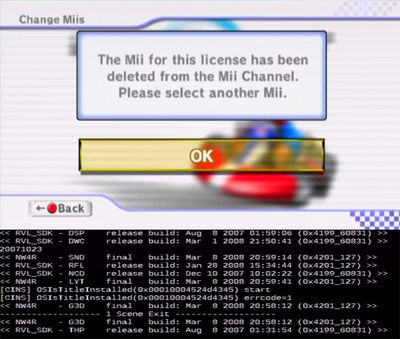
DWC_Log is a method providing logging functionality to the DWC library, which is the library used for online mode (Nintendo WFC). When online, the game outputs messages like "I am New Server!!" to the non-existent console. The developers of the game would have had a cable connected to the console allowing them to view the log on development software. The game also contains debugging messages using the printf method, which are also sent to the non-existent console.
Draggable Blue Shells
Blue Shells seemed to have been once intended to be held behind the player before they use it. The game contains a list of values for each item that define what the item does when the player uses it; for example, Red Shell uses 0x01, which means that the item is held behind the player and fires when they let go of it. An item like Star would be 0x00, for the game to immediately use the item as the button is pressed. For some odd reason, Blue Shell is listed as 0x01, which means the item should be held behind the player like a red shell, though the game has code to prevent this and instead have the player immediately fire it. Disabling this code reveals that the Blue Shell has an unused animation for being held. There's also an unused action for when a player hits it, which works even if the game is modified so that the blue shell lands on the ground if someone loses it. Here is an AR/Gecko code to enable it:
| PAL | NTSC-U | NTSC-J | NTSC-K | |
|---|---|---|---|---|
| Gecko Code | 0048A5B30 00000000 | 048A1058 00000000 | 048A4C90 00000000 | 04893F90 00000000 |
Double-Sized Green Shells
In one of the routines that sets up items, there is code that scales up the green shells (including their hitbox) to double their size when fired (and also when they're stationary in the ground), but only if the course has defined the Big Pokey object (with ID 0x1AB ). This version of the enemy was only used in one competition/tournament, and even then, the only items present there were Bob-Ombs, leaving this functionality unused.
The code that performs these changes starts at 0x80790d1c in RAM (PAL). You can use the following code to enable this functionality outside of this competition/tournament:
| PAL | |
|---|---|
| Gecko Code | 04790D18 60000000 |
(Source: MrBean35000vr)
Unused kartCameraParam.bin Parameters
kartCameraParam.bin in /Race/Common.szs has 3 additional duplicated entries for camera entities that are never used.

Online Squish Command
In the online protocol, there is an unused bit that can make players squished on command. This could mean that originally, players that you hit in a Mega Mushroom on your screen would make them squished globally, instead of just them getting squished on their screen.
Unused Collision Type Effects
Several collision types have unused variants, often showing different sounds/graphical effects.
Slippery Road 1 (does not slow the player) (0x01)
| Effect ID | Description |
|---|---|
| 2 | Water |
| 3 | Snow |
| 4 | Grass |
| 6 | Sand (no graphical effects) |
| 7 | Dirt (no graphical effects) |
Off-road (0x03)
| Effect ID | Description |
|---|---|
| 3 | Water (no graphical effects) |
Slippery Road 2 (slows the player) (0x05)
| Effect ID | Description |
|---|---|
| 1 | Mud |
| 2-5 | Water |
| 6-7 | Normal road, different sound effect |
Boost Panel (0x06)
| Effect ID | Description |
|---|---|
| 2-7 | Unknown |
Boost Ramp (0x07)
| Effect ID | Description |
|---|---|
| 2-7 | The character doesn't do any flips upon tricking. |
Jump Pad (0x08)
| Effect ID | Description |
|---|---|
| 7 | The distance travelled when jumping is the same as for the jump pad found in Mushroom Gorge. |
Item Road (0x09)
This road type is solid for items only.
| Effect ID | Description |
|---|---|
| 4 | Unknown |
| 6-7 | Unknown |
Moving Road (0x0B)
This type moves the player along a predefined route.
| Effect ID | Description |
|---|---|
| 4 | Moving asphalt. Seems to behave like effect 0. |
| 5 | Moving asphalt. Seems to behave like effect 0. |
| 6 | Moving road. Seems to behave like effect 0. |
| 7 | Moving road. Seems to behave like effect 0. |
Invisible Wall (0x0D)
| Effect ID | Description |
|---|---|
| 1-2 | Makes sparks upon contact, and the character emits the sound effect for when hitting a wall. |
| 3-7 | Unknown. Seems to behave like effect 0. |
Item Wall (0x0E)
This wall type is solid for items only.
| Effect ID | Description |
|---|---|
| 4 | Unknown. |
| 6-7 | Unknown. |
Wall 3 (0x0F)
| Effect ID | Description |
|---|---|
| 5 | Bush |
Cannon Activator (0x11)
| Effect ID | Description |
|---|---|
| 3 | Shoots the player to a 3rd destination point defined in the parameters. |
| 4 | Shoots the player to a 4th destination point defined in the parameters. |
| 5 | Shoots the player to a 5th destination point defined in the parameters. |
| 6 | Shoots the player to a 6th destination point defined in the parameters. |
| 7 | Shoots the player to a 7th destination point defined in the parameters. |
Half-pipe Ramp (0x13)
| Effect ID | Description |
|---|---|
| 2-7 | Unknown. |
Wall (0x14)
Much like with the invisible wall, this type only collides with players, and not objects.
| Effect ID | Description |
|---|---|
| 0 | Normal |
| 1 | Rock |
| 2 | Metal |
| 4 | Ice |
| 5 | Bush |
| 6 | Rope |
Moving Road (0x15)
This type of moving road is not controlled by routes defined in the parameters, but by objects.
| Effect ID | Description |
|---|---|
| 6-7 | Unknown. |
Road (0x17)
This type of moving road is not controlled by routes defined in the parameters, but by objects.
| Effect ID | Description |
|---|---|
| 6 | Dirt |
Wall (0x19)
A wall type that affects players, but not items. Only seen in Wario's Gold Mine and Rainbow Road.
| Effect ID | Description |
|---|---|
| 1-7 | Unknown. |
Effect Trigger (0x1A)
| Effect ID | Description |
|---|---|
| 7 | Unknown. |
Item State Modifier (0x1B)
This type is used to stop items dropped in the curved conveyor belts from Toad's Factory.
| Effect ID | Description |
|---|---|
| 1-7 | Unknown. |
Half-Pipe Invisible Wall (0x1C)
| Effect ID | Description |
|---|---|
| 1-7 | Unknown. |
Rotating Road (0x1D)
This type can be found on Chain Chomp Wheel, which is used to rotate the road if the object casino_roulette is present. If it isn't, it will act just like a regular road.
| Effect ID | Description |
|---|---|
| 1 | Normal road with different sound effects. |
| 5 | No sound with star crash impact sound effect, which can only be heard if the object starGate is defined in the parameters. |
| 6 | Sand |
| 7 | Dirt |
Special Wall (0x1E)
A type of wall that has different properties depending on the speed that the player crashes into it with.
| Effect ID | Description |
|---|---|
| 2 |
|
Wall 5 (0x1F)
A type of wall that has different properties depending on the speed that the player crashes into it with.
| Effect ID | Description |
|---|---|
| 1-7 | When driving slow, players won't be able to drive through it, but items can (much like invisible walls). |
Unused Music
These can be found in /sound/strm.
o_FanfareMIWinBoss_32.brstm
This song would have played whenever you win a boss at certain tournaments that had them. However, in the final game, winning a boss plays the same song as for winning in battles. Judging by the filename, it's possible that this theme was intended for use when beating bosses in the early Mission Mode as well. Its song ID is 0x6F .
There is code to load this song starting at RAM address 0x80712408 (PAL): There's a class that controls the background music, and when it plays the opening camera pan music for Competitions/Tournaments, it copies the byte at 0x34 in the RKCO (the intro mode setting inside the Competition/Tournament file) to field 0x74 in itself.
When it gets the results music ID to play, if field 0x74 is set to 3 (intro with Boss music) and it is Competition/Tournament mode (does not include Mission Mode, apparently), the Boss music is enabled. However, it only sets field 0x74 on before the opening pan. When the scene switches from the intro to the actual gameplay scene, the class is reconstructed, causing the field to default back to 1 (intro with Battle music), which results in the Battle winning song being played instead.
STRM_N_TRUCK_N.brstm
The second part of Wario's Gold Mine (inside the mine) has an opening to its track. While technically not unused, this opening is never heard, since the race always starts outside. In addition, no online tournaments taking place in this level start inside.
Unused Sound Effects
Early Trick Sound
| Early | Final |
|---|---|
An early trick sound effect can still be found in /sound/revo_kart.brsar (index 644). It is the fourth sound located inside GRP/GP/N/RAINBOW.brbnk (the sound files for Rainbow Road). Compared to the final version, it has a higher pitch and it is also slightly longer. A similar sound (if not the same) can be heard in a prerelease trailer.
Curiously, a variant of this sound was used in a few competitions/tournaments, more specifically the ones that had the player race a Wiggler, when said character does a trick (named SE_CC_HANACHAN_JUMP_ACTION). However, besides sounding slightly different than the one documented above, it is also sequenced, while both the early and the final trick sounds are streamed.
This sound is actually used in the sequel, Mario Kart 7, when the player does a trick in Rainbow Road and SNES Rainbow Road.
Unused Items
Chain Chomp

While Chain Chomps do appear in Mario Kart Wii as obstacles (in courses such as Mario Circuit or Chain Chomp Wheel/Roulette), there is an icon for the Chain Chomp item as seen in Mario Kart: Double Dash!!. Next to the mouth is the kanji for "temporary" (仮). Interestingly, this Chain Chomp icon can be seen in an early Mario Kart DS prototype without the 仮, but it was replaced by the Bullet Bill in the final.
Boo

Nintendo Power Volume 227 mentions that a Boo item was among the items to be included in the game. The only trace of anything resembling it in the game files is the lack of any behavior for item 0x13. (Normally, if the game tries to execute behavior of an item that doesn't exist, it just gives a mushroom, but the fact that it does nothing implies that an item was present at slot 0x13 at some point and then subsequently stripped from the game.).
Placeholder Items

Three placeholder item icons labeled "NEW1", "NEW2" and "NEW3" are stored in /Scene/UI/Race.szs inside /./game_image/timg, named from left to right tt_item_new1.tpl, tt_item_new2.tpl, and tt_item_new3.tpl. They are obviously unused.
Empty or Deleted Folders & Files
Debug Folder
| | To do: Do the leftover strings actually refer to /debug (in the filesystem's root) or instead to /debug inside /Scene/UI/Channel.szs? There are also strings referring to the letter files in the subdirectory /LetterForm inside that same .szs file. |
An empty folder named debug can be found in the game's file system. Its exact purpose is unknown. File paths in the executable referring to this folder also contain names of letter texture files (the envelope and content of letters) being posted to the Wii Message Board and the ones being received when a tournament starts. Maybe Nintendo used this to more easily test new variants of the letter?
A list of files that once resided here are located within the game's code.
- thumb_jp_d.bin
- letter_jp_d.bin
- thumb_jp_v.bin
- letter_jp_v.bin
- thumb_jp_c.bin
- letter_jp_c.bin
- thumb_nj_d.bin
- letter_nj_d.bin
- thumb_nj_v.bin
- letter_nj_v.bin
- thumb_nj_c.bin
- letter_nj_c.bin
MissionRun Folder
Another empty folder, called "Race/MissionRun" (the Japanese and Korean name for Mission Mode), can be found in the game's files. It has been discovered that file resources for Mission Mode, such as mission_single.kmt and mrXX.szs, would have been found here.
.svn Folders
All of the game directories (except for /debug and /Race/MissionRun) contain an empty folder named .svn. This is a leftover from Apache Subversion, a version control system. All of these folders were removed in the Korean version of the game (except for one).
Scrapped 3D Wiimote Model
Strings exist for a file called wii_controller.brres which would reside within Race/Common.szs. BRRES files are visual model files, but a file of this name/description exists nowhere on the disc.
Scrapped Character Sound Method
| | To do: Add the information from the video here. |
In the game's code, there is a definition of a BRASD folder inside of the character archive files.
Unused Dutch Language
Oddly, Dutch is the only selectable language in the Wii Menu that is not available as a language option for Mario Kart Wii; though if your Wii is set to Dutch, the Home Button menu and Wii Remote safety screens will be in Dutch and the rest of the game will be in English. This seems to not have always been the case, however, as the code that detects which language is set in the Wii menu and adjust the game accordingly has an unused pointer to a set of files that end with "_N.szs" (N standing for Netherlands).
Unused _Dif Files
Similarly to the section above, another reference exists in the code for files ending with "_Dif.szs". Supposedly, these files were meant to be used as multiplayer variants for the courses. The game would have loaded the original course file as a base, and then the "_Dif" file would contain a few modified files from the base course that would eventually be replaced with the respective ones from Single Player at runtime to create the multiplayer version of the track. While a similar approach was used for competitions/tournaments, as well as in the unused Mission mode, the final multiplayer versions of the tracks are actually stored in the disc itself, ending with "_d.szs", which already contain all the necessary files to load the entire course.
BMS Files
Strings in the game's memory refer to .bms files, but these files exist nowhere on the disc. They were probably similar to BMM Files.
BFOG and BFOBJ Files
BFOG and BFOBJ Files are defined in the code, but the game only uses BFG Files instead, probably because they have a simpler format. This may be a remnant from New Super Mario Bros. Wii, as both games share the same EGG library.
BDOF (Binary Depth Of Field) is a post-effect file that controls effects like focus, sharpness, and blur in tracks.
There is unused code that allows the usage of a secondary BDOF file, named posteffect.bdof_demo. This one has the same format as a normal BDOF file, and it seems to be used only in the course introduction if present.
Removed Symbol Maps
At offsets 0x241B2C and 0x241F28 respectively (PAL) of the main.dol executable resides leftover strings for two missing symbol maps: StaticR.SMAP (for StaticR.rel) and RevoKartR.SMAP. The Home Menu version of the Mario Kart Channel also mentions another removed symbol map for it at offset 0x313EC8 (PAL) of its main.dol executable variant, named RevoKartNR.SMAP. All of these files would have resided in the /rel directory.
Interestingly, there is leftover code to load the RevoKartR.SMAP file, as shown in the following decompiled code:
if (MAIN_SMAP != nullptr) // "/rel/RevoKartR.SMAP" { u32 map_size; mpMap = SystemManager::sInstance->ripFromDisc(MAIN_SMAP, pModuleInfo, 0, &map_size, 0); if (mpMap != nullptr) { EGG::Exception::setMapFile(mpMap, map_size, pModuleInfo); OSReport("[SYS] Load MapFile \"%s\" success.\n", MAIN_SMAP); } else { OSReport("[SYS] Load MapFile \"%s\" fail.\n", MAIN_SMAP); } } Alternative Mario Kart Channel version
At offset 0x37F4A4 (PAL) of StaticR.rel, there's a string referring to a missing version of the Home Menu version of the Mario Kart Channel, named RevoKartTR.wad (for reference, the final version is named RevoKartNR.wad).
RKChRes.arc
At offset 0x241173 (PAL) of the main.dol executable there is a string that mentions a removed file, named RKChRes.arc, that would have resided in the root of the game's filesystem. While it is unclear what this file would have been for, it is listed alongside the files from the /contents directory inside an array in the game's code, which also reveals that it has an ID assigned to it (8).
Interestingly, the IDs assigned to the files from the /content directory in said array match the numbering of the equivalent files from the extracted Mario Kart Channel, plus 00000008.app contains most directories and files found in the main game's filesystem root, which matches how RKChRes.arc would have resided in the root. Sadly, said file is not found in that .app container either.
Unused Modes
Mission Mode
| | To do: See if you can record what might have been for the videos that no longer exist in the game; also, rename and reformat them to the videos' names and try to see if that changes anything. Try recording in-game footage of doing those things. |
There was originally a Mission Mode planned for Mario Kart Wii. All of the missions that were originally created for the mode have been wiped from the game disc, and thus have been lost. It is very similar to tournament mode on WiiConnect24. You can even port tournaments to Mission Mode and it will work almost exactly the same, which means that it is possible that missions originally created for Mission Mode were ported over to be tournaments.
The menus for Mission Mode have no available text, but the game is trying to load them; they've simply been erased. The only surviving piece of text is "Choose a Mission" after finishing a mission. Similarly, a massive file that would've contained mission parameters is not present, and without it, the mode can't start - unless you simulate its existence. The sub-routine still exists, though. It attempts to load files out of the /Race/MissionRun folder on the disc, but that folder is empty. The files would have contained things like where to place objects, the objective, the score required, the time limit, the engine class, which character and kart you were restricted to, etc. Because this content is missing, it is impossible to know what the original missions were.
Some of the surviving content is drift restrictions on some levels, and/or a video (but since the videos are missing, the game just displays a still image of the last loaded video). The last level with a video is 2-4, and that's most likely where they decided that they weren't going through with it. The game doesn't even attempt to load any mission that is 3-4 or later. Interestingly, the code for trying to load the videos still has the original video names.
Here is a list:
| Filename | Estimation of Contents |
|---|---|
| 00_curve.thp | Steering without drifting (?) |
| 01_drift.thp | Manual Drifting |
| 02_miniturbo.thp | Obtaining miniturbos from Manual Drift |
| 03_autodrift.thp | Automatic Drifting |
| 04_jumpaction.thp | Performing tricks on ramps |
| 05_halfpipejump.thp | Performing tricks on halfpipe ramps |
| 06_wheelie.thp | Performing wheelies |
| 07_spinturn.thp | Turning on the spot (using A+B) |
| 08_back.thp | Reversing (?) |
| 09_startdush.thp | Getting a boost start in the countdown |
| 10_jugemdush.thp | Getting a boost start after respawning |
| 11_slipstream.thp | Getting a slipstream from another racer |
| 12_itemthrow.thp | Throwing/using items |
| 13_itemequip.thp | Dragging items behind you |
There is no penalty for losing, as the win music plays, and the results screen is bugged.
Game Modes
There seems to be 14 valid game modes.
| ID | Code Name | Objective |
|---|---|---|
| 0x00 | MiniTurbo | Release miniturbos to score points. |
| 0x01 | LapRun01 | VS Mode. Complete 3 laps before time runs out. |
| 0x02 | LapRun02 | VS Mode. Complete 3 laps before time runs out. (Seems identical to mode 0x01). |
| 0x03 | Drift | Perform any drift to score. (Faulty, increments score too quickly, Manual only) |
| 0x04 | ItemBox | Break item boxes to score points. |
| 0x05 | EnemyDown01 | Hit enemies with items to score points. |
| 0x06 | EnemyDown02 | Attack a boss to score points. (E.g. Spiky Topmen, Big Pokey, etc) |
| 0x07 | EnemyDown03 | Unknown. (Most likely unused or deleted. A piece of text in StaticR.rel, "EnemyDown03" may indicate it used to be related to modes 0x05 and 0x06, attacking something). |
| 0x08 | CoinGet01 | Gather coins to score points. |
| 0x09 | ToGate01 | Drive through gates to score points. |
| 0x0A | RocketStart | Perform any level of boost start to immediately win the mission. (If you miss the boost start, you can no longer win, at all). |
| 0x0B | ItemHit | Hit CPU opponents with certain items to score points. (All projectiles. Stars, Mushrooms, Mega Mushrooms and Bullet Bills do not score). |
| 0x0C | Wheelie | Perform wheelies to score. (Faulty, increments score too quickly, increments for wheelies on the spot). |
| 0x0D | Slipstream | Get slipstreams from CPU opponents to score points. (However, the score also increases if they slipstream someone, too). |
There are code names for each of these modes which include an extra 12 of them. The names of them suggest that more were planned but weren't coded.
The names for the extra 12 are: BalloonBattle, CoinBattle, Jump+Halfpipe01, Jump+Halfpipe02, Star3, Star2, Star1, A, B, C, D, E.
Though it is unknown, Star3, Star2, Star1, A, B, C, D, and E seem to represent ranking in order from best to worst from the GP ranking design. It is unknown why these are listed as game modes.
Unused/Disabled Menu Content
A piece of text found in the layout files, ジャンプアクション, translates directly to Jump action. This text is in common_w088_mission_movie, which is the file responsible for the layout of the mission select (or sub-level) button. jump_action is the code name for half-pipe tricks; along with the two referenced code names and the tutorial THP file, this suggests there was going to be a game mode, or maybe two, with an objective of tricking.
There is also supposed to be a level number on the left side of the mission select buttons (buttons on the right). This text is taken straight from the layout file, which only has one text entry, "1-1", but because of font limitations, the text would appear as "1?1" in game. The reason why this doesn't appear is because it's applied to the button but then immediately overwritten by the text appearing in the center of the button, the mission name. The text normally supplied is loaded as the text in the center and as the level number.
A star is intended to appear on the right side of the level select buttons. It does actually appear, but is behind the button, making it impossible to see.
A button exists for Mission Mode on the Single Player Menu, and oddly enough on the Multiplayer Menu as well. Both of the buttons crash the game when selected because they link to the Mission Mode screens, which aren't loaded in that context. Loading the Mission Mode screens on the Single Player Menu causes the button to work, but loading them on the Multiplayer Menu crashes because it lacks the necessary files for the screens, like layouts, textures, etc.
Accessing Mission Mode
A code to access Mission Mode and more information is available at the Custom Mario Kart Wiiki.
Special Ghosts Mode
Nintendo had once delivered "special ghost" events. If a special ghost was available, you would find it in the Time Trial rankings for its course. A notification would appear in the main menu of the Mario Kart Channel, and selecting it would take you directly to the ghost in the rankings menu. Once highlighting the ghost, the bottom right text would simply say "Battle [name]." and would prompt you to connect to Nintendo WFC once you select it. Special ghosts are mentioned several times in the game's text:
| Text ID | Text |
|---|---|
| 0x1C85 | Join the message service to have the latest updates from the Mario Kart Channel posted to your Wii Message Board via WiiConnect24. You can opt out at any time. Messages will include information about: ・competitions |
| 0x1901 | Special ghost data now available! |
| 0x17AF | Special Ghost Data |
These pieces of text were translated to all languages.
The game's manual also makes mention of special ghosts, showing a unique icon that isn't used anywhere else in the game, although it's present within the Mario Kart Channel's banner files, named tk_iconGhost_00.

![]()
Early File Leftovers
In Scene/UI/ are a bunch of unused .bin files that seem to be very slightly early versions of the used .bin files (located in /Race/Common.szs).
kartParam.bin
This file controls the statistics of the vehicles.
Three "Tilt Strength" values for certain karts have been lowered in the final game.
| Kart | Early Value | Final Value |
|---|---|---|
| Standard Kart L | 0.02 | 0.015 |
| Tiny Titan | 0.03 | 0.02 |
| Sprinter | 0.02 | 0.015 |
driverParam.bin
This file controls the statistics of the characters.
Several "Slippery Road Type 2" speed values were changed as well.
| Character | Early Value | Final Value |
|---|---|---|
| Toadette | 0.01368 | 0.01283 |
| Yoshi | 0.01368 | 0.01283 |
| Birdo | 0.00684 | 0.00641 |
| Bowser Jr. | 0.00684 | 0.00641 |
| Medium Mii | 0.00684 | 0.00641 |
| Wario | 0.00684 | 0.00641 |
| Waluigi | 0.00684 | 0.00641 |
| King Boo | 0.00684 | 0.00641 |
| Funky Kong | 0.00684 | 0.00641 |
| Dry Bowser | 0.01368 | 0.01283 |
kartCameraParam.bin
This file controls the position of the camera for the vehicles.
Two camera parameters have been ever-so-slightly changed.
| Early Near Camera 1 | Final Near Camera 1 |
|---|---|
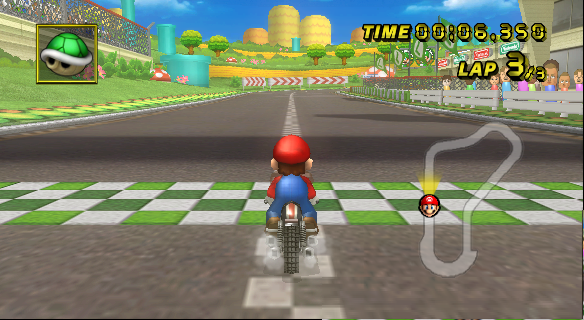 | 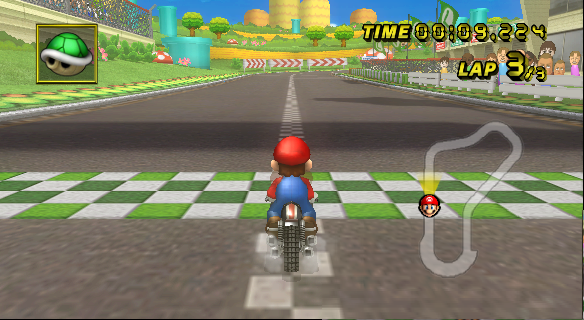 |
| Early Near Camera 2 | Final Near Camera 2 |
|---|---|
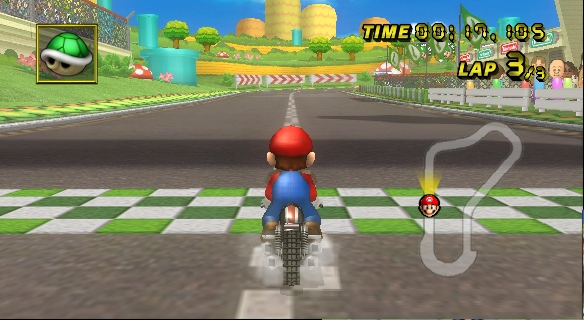 | 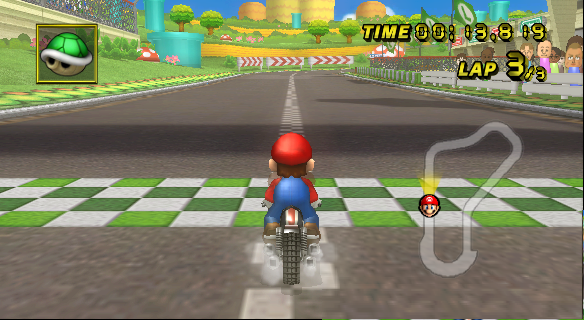 |
Unreleased Chinese Version
Exclusively on the Korean disc, there are files that seem to suggest that a Chinese version of Mario Kart Wii was in development for the Wii. A Chinese version of the game was announced for the NVIDIA Shield almost a decade after the original's release.
Simplified Chinese Logo
Found in the banner data of the game.
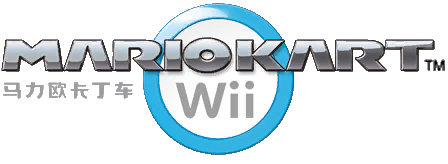
(Source: [UNOFFICIAL Chinese Nintendo Twitter])
Chinese Safety Screen
Found in Boot\Strap\ch\Chinese.szs are the two Wii Remote safety screen pages in Simplified Chinese.
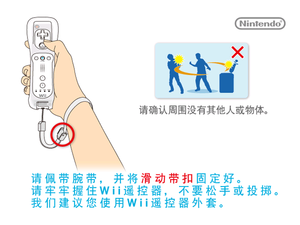
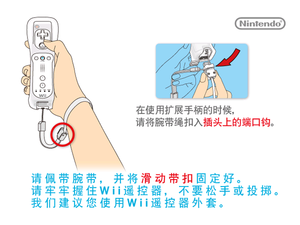
isbn_608x456
Found in Boot\Strap\ch\isbn_608x456.szs is a weird file. It is a Chinese splash screen. The upper, larger text is the "Healthy gaming advice", a 28-character health & safety advice that is required to be displayed upon a game's startup by Chinese law. The lower half consists of the publishing house information and a placeholder ISBN with all zeroes (the ISBN will be replaced by the actual one given by the government upon approval). The publisher is the exact same one used by all games published by iQue.
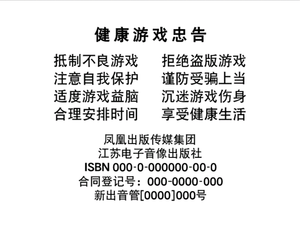
It roughly translates to
"Healthy Gaming Advice Resist unhealthy games, reject pirated games Be aware of self-protection, avoid being deceived Moderate gaming is good for the brain, addiction to games hurts your body Manage time appropriately, enjoy a healthy life"
(Source: [UNOFFICIAL Chinese Nintendo Twitter])
Found in the hbm folder is homeBtn_CHN.szs
If you replace the normal homeBtn file with this one and load it in-game, it is still mostly functional, besides a few missing bits of text.
Interestingly, if you change the language in Dolphin to "S. Chinese", then the text properly displays:
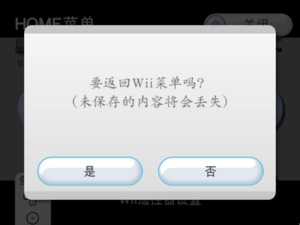

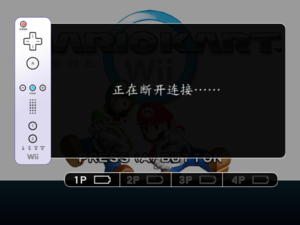
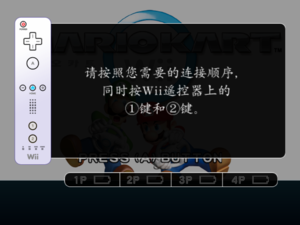
Uncompiled Camera Animation
Present in Demo/Ending.szs/Camera is just an uncompiled camera animation file titled dummy.rsca, created on 2007-11-05 16:10:33 by Eriko Kimura, from the Demo Movie team. A binary format of said file doesn't exist in the archive, so this most likely went unused. The Model folder inside it is empty.
<?xml version="1.0" encoding="utf-8"?> <nw4r_3dif version="1.3.0" xmlns="http://www.nintendo.co.jp/NW4R/3DIntermediateFileFormat" xmlns:xsi="http://www.w3.org/2001/XMLSchema-instance" xsi:schemaLocation="http://www.nintendo.co.jp/NW4R/3DIntermediateFileFormat ver_1_3_0/rsca.xsd" > <head> <create user="kimura_eriko" host="KIMURAE-GRP" date="2007-11-05T16:10:33" source="los_cam.ma"/> <title>Scene Animation Data</title> <generator name="NW4R_Export for Maya 8.5 Service Pack 1" version="1.3.1"/> </head> <body> <rsca> <scene_anim_info frame_size="2" tool_start_frame="1" tool_end_frame="2" magnify="10.000000" bake_animation="on" frame_precision="1_1" loop="off" tolerance_rotate="0.100000" tolerance_translate="0.010000" tolerance_color="1.000000" /> <camera_anim_array size="1"> <camera_anim index="0" name="los_camera" camera_type="rotate" projection_type="perspective" ref_number="0" > <camera_anim_target target="pos_x"> <anim_constant value="-12676.701172"/> </camera_anim_target> <camera_anim_target target="pos_y"> <anim_constant value="6468.499023"/> </camera_anim_target> <camera_anim_target target="pos_z"> <anim_constant value="53316.898438"/> </camera_anim_target> <camera_anim_target target="aim_x"> <anim_constant value="0.000000"/> </camera_anim_target> <camera_anim_target target="aim_y"> <anim_constant value="0.000000"/> </camera_anim_target> <camera_anim_target target="aim_z"> <anim_constant value="0.000000"/> </camera_anim_target> <camera_anim_target target="rot_x"> <anim_constant value="-5.138353"/> </camera_anim_target> <camera_anim_target target="rot_y"> <anim_constant value="-37.400002"/> </camera_anim_target> <camera_anim_target target="rot_z"> <anim_constant value="0.000000"/> </camera_anim_target> <camera_anim_target target="twist"> <anim_constant value="0.000000"/> </camera_anim_target> <camera_anim_target target="aspect"> <anim_constant value="1.500000"/> </camera_anim_target> <camera_anim_target target="near"> <anim_constant value="1.000000"/> </camera_anim_target> <camera_anim_target target="far"> <anim_constant value="1000000.000000"/> </camera_anim_target> <camera_anim_target target="persp_fovy"> <anim_constant value="58.445305"/> </camera_anim_target> <camera_anim_target target="ortho_height"> <anim_constant value="100.000000"/> </camera_anim_target> </camera_anim> </camera_anim_array> </rsca> </body> </nw4r_3dif>
| Early | Final |
|---|---|
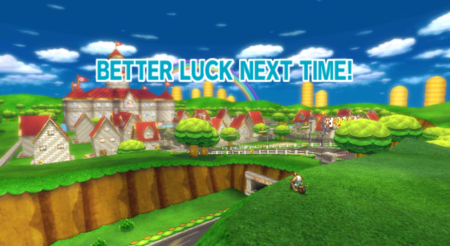 |  |
It is actually possible to compile this code back to a binary file, which reveals an earlier camera angle used for the total results screen that can be seen when the player loses a Grand Prix/VS Race/Battle.
Internal Project Name
The game is referred to internally as RevoKart. Revo is short for "Revolution", the Wii's internal project name. course.0 also indicates the project name as RVL-MarioKart.
(Source: Original TCRF research)
Regional Differences
Title Screen
| Japan | America | Europe | Korea |
|---|---|---|---|
| | | | |
- The Press the A Button text from the European and American releases is PRESS (A) BUTTON in the Japanese and Korean versions.
- The European and Korean versions display the trademark as TM, while in the Japanese and American builds it is an R.
- The Korean version displays the year 2009 in the copyright text, reflecting its actual release date. This is positioned lower than in the rest of the versions, and in addition, the font here is in bold.
- Both the Japanese and Korean releases display the game's name in their respective languages under the romanized logo.
- Both the Japanese and Korean versions have a mistake in which the "R" from the MARIOKART logo is missing one of its corners, making the logo slightly thinner.
- The Korean version fixes a small oversight in which Luigi's Kart shadow was slightly cut in the bottom left corner.
- The Korean release (unlike with the Japanese version) has the same blur version of the background image as the one used in the European and American releases, despite its title screen having more differences, such as the game's name in Korean.
License Selection Screen and Main Menu
| Japan | Korea |
|---|---|
| | |
- When setting the console's aspect ratio to 16:9, the Korean version will display the Title Screen image slightly offset to the left, which could be seen in a prerelease screenshot.
- In the European version, the 1/2/3/4 players' text numbers are slightly bigger than in the American version. In contrast, the "Player(s)" text is slightly larger in the American release in comparison to the European one.
Font
- The Korean release uses a completely different font from the one seen in the other versions.
- The icon graphics for the controller buttons are noticeably smaller in the Korean version (as seen in the "Back" button, for example). They are also positioned slightly lower than in all other versions.
| The Mario series | |
|---|---|
| NES/FDS | Super Mario Bros. • Super Mario Bros 2. (FDS) • Super Mario Bros. 2 (NES) (Prototype, Doki Doki Panic) • Super Mario Bros. 3 |
| SNES | Super Mario World • Super Mario All-Stars • Super Mario World 2: Yoshi's Island (Prototypes) |
| Satellaview | BS Super Mario USA • BS Super Mario Collection |
| Nintendo 64 | Super Mario 64 (64DD Version) |
| GameCube | Super Mario Sunshine (Demo) |
| Wii | Super Mario Galaxy • Super Mario Galaxy 2 • New Super Mario Bros. Wii |
| Wii U | New Super Mario Bros. U • New Super Luigi U • Super Mario 3D World |
| Game Boy (Color) | Super Mario Land • Super Mario Land 2: 6 Golden Coins • Wario Land: Super Mario Land 3 • Super Mario Bros. Deluxe |
| Game Boy Advance | Super Mario Advance • Super Mario Advance 2 • Super Mario Advance 3 • Super Mario Advance 4 |
| Nintendo DS | New Super Mario Bros. • Super Mario 64 DS |
| Nintendo 3DS | Super Mario 3D Land (Demo) • New Super Mario Bros. 2 |
| Nintendo Switch | Super Mario Odyssey • New Super Mario Bros. U Deluxe • Super Mario 3D All-Stars • Super Mario Bros. 35 • Super Mario 3D World + Bowser's Fury |
| iOS/Android | Super Mario Run |
| Mario Kart | |
| Console Games | Super Mario Kart (Prototypes) • Mario Kart 64 (iQue Prototype) • Mario Kart: Double Dash!! (Demos) • Mario Kart Wii (Mario Kart Channel) • Mario Kart 8 (Deluxe) |
| Handheld Games | Mario Kart: Super Circuit • Mario Kart DS (Demos) • Mario Kart 7 • Mario Kart Tour |
| Arcade Games | Mario Kart Arcade GP • Mario Kart Arcade GP 2 • Mario Kart Arcade GP DX |
| Mario RPGs | |
| Super Mario RPG | Legend of the Seven Stars |
| Paper Mario | Paper Mario • The Thousand-Year Door (Paper Mario 2 Demo) • Super Paper Mario • Sticker Star • Color Splash • The Origami King |
| Mario & Luigi | Superstar Saga (+ Bowser's Minions) • Partners in Time • Bowser's Inside Story (+ Bowser Jr.'s Journey) • Dream Team • Paper Jam |
| Mario Party | |
| Console Games | Mario Party • Mario Party 2 • Mario Party 3 • Mario Party 4 (Demo) • Mario Party 5 (Demo) • Mario Party 6 (Demo) • Mario Party 7 • Mario Party 8 • Mario Party 9 • Mario Party 10 • Super Mario Party • Mario Party Superstars |
| Handheld Games | Mario Party Advance • Mario Party DS |
| Web Games | Mario Party 7: Bowser's Lair Hockey |
| Mario Sports | |
| Golf | NES Open Tournament Golf • Mario Golf (Nintendo 64, GBC) • Mario Golf: Toadstool Tour • Mario Golf: Advance Tour • Mobile Golf |
| Tennis | Mario Tennis (Nintendo 64, GBC, Virtual Boy) • Mario Power Tennis • Mario Tennis: Power Tour - Bicep Pump • Mario Tennis Aces • Mario Tennis: Power Tour |
| Strikers | Super Mario Strikers (Demo) • Mario Strikers Charged |
| Mario & Sonic at the Olympic Games | Beijing 2008 (DS, Wii) • Vancouver 2010 (Wii) • London 2012 • Rio 2016 (Wii U) |
| Other | BS Excitebike Bunbun Mario Battle Stadium • Super Mario Bros. + Duck Hunt + World Class Track Meet • Dance Dance Revolution Mario Mix • Mario Superstar Baseball (Mario Baseball Demo) • Mario Sports Mix • Mario Pinball Land |
| Dr. Mario | |
| Console Games | Dr. Mario (Prototypes) • Tetris & Dr. Mario • Dr. Mario 64 • Dr. Luigi |
| Handheld Games | Dr. Mario • Dr. Mario & Puzzle League • Dr. Mario World |
| Web Games | Dr. Mario: Vitamin Toss |
| Super Mario Maker | |
| Console Games | Super Mario Maker • Super Mario Maker 2 |
| Handheld Games | Super Mario Maker for Nintendo 3DS |
| Mario vs. Donkey Kong | |
| Handheld Games | Mario vs. Donkey Kong (Demo) • Mario vs. Donkey Kong 2: March of the Minis (Demo) • Mario vs. Donkey Kong: Minis March Again! • Mario vs. Donkey Kong: Mini Land Mayhem! |
| Console Games | Mini Mario & Friends: amiibo Challenge |
| Mario Paint/Artist | |
| Console Games | Mario Paint (Prototype) • Mario no Photopi • Mario Artist Paint Studio (Prototype) • Mario Artist Talent Studio • Mario Artist Communication Kit • Mario Artist Polygon Studio |
| Mario Bros. | |
| Arcade Games | Mario Bros. • Donkey Kong, Donkey Kong Jr., Mario Bros. |
| Console Games | Mario Bros. • Kaettekita Mario Bros. |
| Handheld Games | Mario Bros. Classic • Mario Clash |
| Luigi's Mansion | |
| Console Games | Luigi's Mansion • Luigi's Mansion 3 |
| Handheld Games | Luigi's Mansion • Luigi's Mansion: Dark Moon |
| Arcade Games | Luigi's Mansion Arcade |
| Mario's Picross | |
| Console Games | Mario's Super Picross |
| Handheld Games | Mario's Picross • Picross 2 |
| Educational | |
| Computer Games | Mario is Missing! (DOS) • Mario's Early Years (DOS) |
| Console Games | Mario is Missing! (NES, SNES) • Mario's Time Machine (NES, SNES) • Mario's Early Years (Fun With Letters) |
| Donkey Kong | |
| Arcade Games | Donkey Kong • Donkey Kong Jr. • Donkey Kong, Donkey Kong Jr., Mario Bros. |
| Computer Games | Donkey Kong (Atari 8-bit family) (Prototype) |
| Console Games | Donkey Kong (NES) • Donkey Kong Jr. (NES) |
| Handheld Games | Donkey Kong (Game Boy) |
| Wrecking Crew | |
| Console Games | Wrecking Crew • Wrecking Crew '98 |
| Other | |
| Arcade Games | Mario Roulette |
| Computer Games | Mario's Game Gallery |
| Console Games | I am a Teacher: Super Mario no Sweater • Nintendo World Championships 1990 • Mario & Wario • Undake 30: Same Game Mario Version • Yoshi's Safari • Hotel Mario • Super Mario's Wacky Worlds • Fortune Street • Captain Toad: Treasure Tracker (Wii U, Switch) • Mario + Rabbids Kingdom Battle |
| Handheld Games | Jaguar Mishin Sashi Senyou Soft: Mario Family • Super Princess Peach • Captain Toad: Treasure Tracker (Nintendo 3DS) • Photos with Mario |
| See also | |
| Yoshi • Donkey Kong • Wario | |
Mkw Custom Track Mario Kart Arcade Gp 2
Source: https://tcrf.net/Mario_Kart_Wii




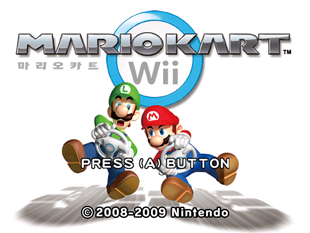
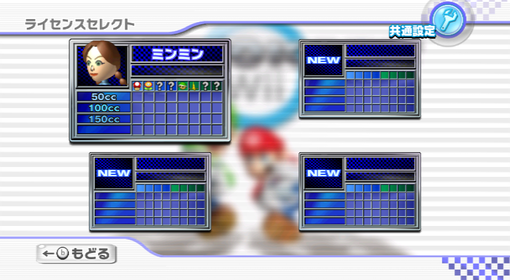
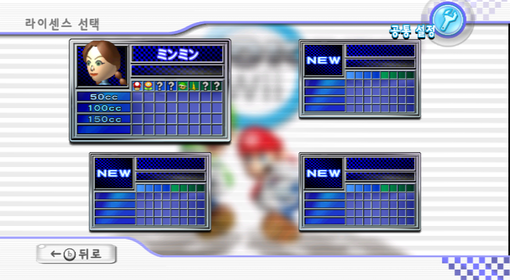
Postar um comentário for "Mkw Custom Track Mario Kart Arcade Gp 2"